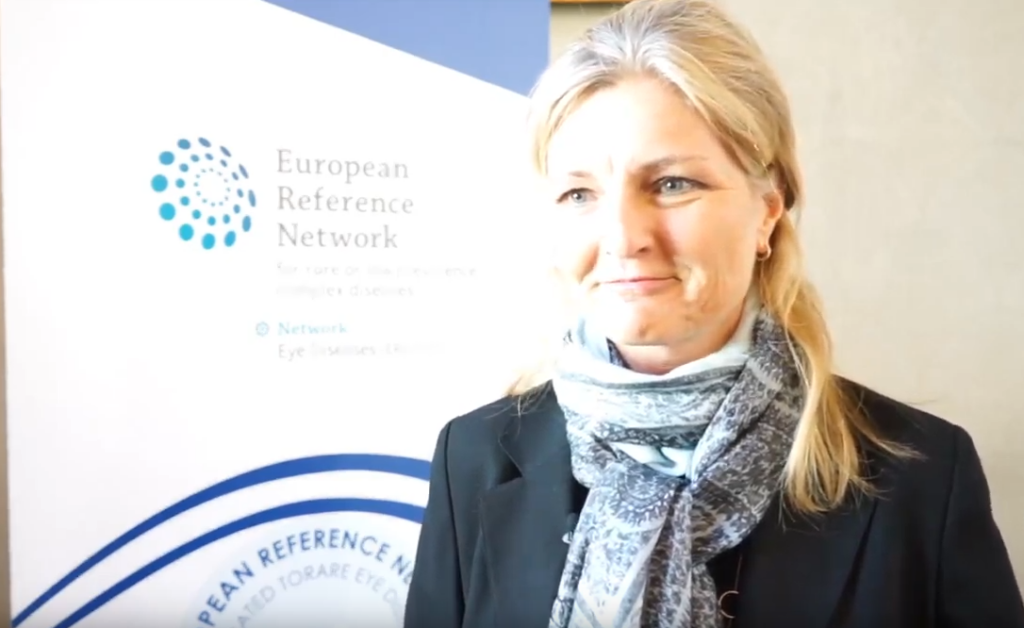Every month, ERN-EYE invites you to meet an active person within the network through a short interview. This month, it’s Dominique Sturz, ePag representative, who accepted to answer our questions.
“The best advance is that ERN-EYE is there, that it is reality, that it has been established and that works and that things are working and that very dedicated people are there who get things going.”
My name is Dominique Sturz and I’m a patient advocate for Usher syndrome, rare eye diseases and rare diseases in general. I’m based in Austria and I’m also a mother of a young adult with Usher syndrome subtype one. In the early 90s, I started as an ambassador and patient advocate for a bilateral early cochlear implantation and then we got the diagnosis of retinitis pigmentosa in addition to deafness in 2005 into our family which was genetically confirmed in 2012 USH1B and this since then I’ve been advocating for early diagnosis of Usher syndrome and rare eye diseases and I’ve been running the Usher Initiative Austria since 2012-2013.

I’m also founder and initiator of Usher Deafblind Austria which is an organization focusing on deafblindness and disability advocacy in our country and well I’m also on board of the Austrian rare disease Alliance Pro Rare Austria and involved in Rare diseases strategies in our country and also on international level and well, last but not least, I’m coordinator of the special interest group for Usher syndrome at Retina International and I joined ERN-EYE a year ago, in March 2018, as an ePag as a patient advocate. In the ERN-EYE, I’m assigned to the work group “pediatrics” and “education and training” which fits perfectly into my personal original mission to advocate for early diagnosis through genetic testing in young children and in young families. As a patient advocate, we just have to make sure that the mission of ERN-EYE is fulfilled in the interest of patients and patient groups and their organizations.
What is the most important issue ERN-EYE could overcome?
Well, there are many but one might be whilst thinking globally, we have to act locally at the same time and this is sometimes very difficult when it comes to implementation of rare Rare Eye Diseases strategies on national levels in our countries. We need the collaboration with the important stakeholders like health ministries and other institutions. Because otherwise if we don’t do that the idea and the mission of ERN-EYE which is not only promote research to find treatments but also giving access to all citizens within the European Union. If we don’t have this collaboration with our national health authorities the idea of ERN-EYE would fail and that would be a shame.
What are the main challenges of the network?
Well besides many, let’s say practical and operational challenges, like the registry on European level like CPMS, like guidelines, we have also a strategic challenge to overcome which might be to cover the white spots in the European map and including those countries which are not in the network yet to have them affiliated in which institution whatever and to fulfill one of the most important missions of ERN-EYE : to give access to expertise to all countries within the European Union.
What are the best advances?
Well, I would say that ERN-EYE is there, that it is reality, that it has been established and that it works and that things are working and that very dedicated people are there who get things going. So like, I mean, the efforts and the energy and the dedication that the coordinator and the coordinating teams dedicated to the work of ERN-EYE and also the HCPs with their time, their efforts and their engagements, and last but not least the patient advocates and their organizations, above all Retina International, and also their willingness to all together to continue to work on to make ERN-EYE successful.
What are your dreams, what would ERN-EYE look like in 10 years?
Well, I have many dreams but for ERN-EYE, I would say in 10 years we should have cross-border consultations, cross-border healthcare for every citizen in the European Union and also we should have a very strong ERN-EYE network, a strong, so a European network strong and united to be able to be a global player in the global setting interesting for international cooperations and collaborations, let’s say with the US, Canada or other
continents, and all this in the interest of patients with the mission to find treatments, to find cure and to provide appropriate disease management with all its aspects, not only the medical side but also the full range of psychosocial and social aspect should be included.

